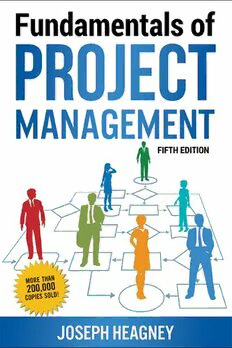
Fundamentals of Project Managementw PDF
Preview Fundamentals of Project Managementw
Thank you for downloading this AMACOM eBook. Sign up for our newsletter, AMACOM BookAlert, and receive special offers, access to free samples, and info on the latest new releases from AMACOM, the book publishing division of American Management Association. To sign up, visit our website: www.amacombooks.org Fundamentals of PROJECT MANAGEMENT FIFTH EDITION Fundamentals of PROJECT MANAGEMENT FIFTH EDITION JOSEPH HEAGNEY AMERICAN MANAGEMENT ASSOCIATION New York • Atlanta • Brussels • Chicago • Mexico City • San Francisco • Shanghai Tokyo • Toronto • Washington, D.C. To Susan Heagney, my wife and friend for forty years CONTENTS Figure List ix Preface to the Fifth Edition xi CHAPTER 1 An Overview of Project Management 1 CHAPTER 2 The Role of the Project Manager 25 CHAPTER 3 Planning the Project 33 CHAPTER 4 Incorporating Stakeholder Management in the Project Planning Process 47 CHAPTER 5 Developing a Mission, Vision, Goals, and Objectives for the Project 59 CHAPTER 6 Creating the Project Risk and Communication Plans 69 CHAPTER 7 Using the Work Breakdown Structure to Plan a Project 85 CHAPTER 8 Scheduling Project Work 103 CHAPTER 9 Producing a Workable Schedule 115 CHAPTER 10 Project Control and Evaluation 133 CHAPTER 11 The Change Control Process 147 CHAPTER 12 Project Control Using Earned Value Analysis 161 CHAPTER 13 Managing the Project Team 175 CHAPTER 14 The Project Manager as Leader 187 CHAPTER 15 Closing the Project 199 CHAPTER 16 How to Make Project Management Work in Your Company 209 Acknowledgments 215 Answers to Exercises 217 About the Authors 221 Index 223 Free Sample Chapter from Emotional Intelligence for Project Managers by Anthony Mersino 228 About Amacom 250 FIGURE LIST 1-1. Triangles showing the relationships among P, C, T, and S. 1-2. Life cycle of a troubled project. 1-3. Appropriate project life cycle. 1-4. The steps in managing a project. 3-1. Two pain curves in a project over time. 3-2. Planning is answering questions. 4-1. The stakeholder grid. 4-2. The Stakeholder Engagement Assessment Matrix. 4-3. Audience guide to knowledge and communication. 4-4. The five cultural dimensions. 5-1. Chevron showing mission, vision, and problem statement. 5-2. Risk analysis example. 6-1. Risk matrix. 6-2. Risk register. 6-3. Communication plan. 7-1. WBS diagram to clean a room. 7-2. WBS level names. 7-3. Partial WBS. 7-4. Responsibility chart. 7-5. Human productivity. 7-6. Time, cost, resource trade-off. 7-7. Calculating the standard average. 7-8. Calculating the PERT weighted average. 8-1. Bar chart. 8-2. Arrow diagrams. 8-3. WBS to do yard project. [ ix ] [ x ] Figure liST 8-4. CPM diagram for yard project. 8-5. WBS to clean room. 9-1. Network to illustrate computation methods. 9-2. Diagram with EF times filled in. 9-3. Diagram showing critical path. 9-4. Bar chart schedule for yard project. 9-5. Schedule with resources overloaded. 9-6. Schedule using float to level resources. 9-7. Schedule with inadequate float on C to permit leveling. 9-8. Schedule under resource-critical conditions. 9-9. Network for exercise. 11-1. Triple constraints triangle. 11-2. Project change control form. 11-3. Project change control log. 12-1. BCWS curve. 12-2. Bar chart schedule illustrating cumulative spending. 12-3. Cumulative spending for the sample bar chart. 12-4. Plot showing project behind schedule and overspent. 12-5. Project ahead of schedule, spending correctly. 12-6. Project is behind schedule but spending correctly. 12-7. Project is ahead of schedule and underspent. 12-8. Percentage complete curve. 12-9. Earned value report. 14-1. Leadership style and alignment. 15-1. Lessons-learned analysis. 15-2. Project closure checklist. 15-3. Early termination/cancellation chart. A-1. WBS for the camping trip. A-2. Solution to the WBS exercise. A-3. Solution to the scheduling exercise. PREFACE TO THE FIFTH EDITION Four years have passed since the Fourth Edition of this book was published, and some important indicators in the project man- agement world have changed, while others have remained the same. According to the recent Project Management Institute (PMI®) “Pulse of the Profession” report, the percentage of projects succeeding (meeting their goals) has remained flat at 64 percent between 2012 and 2015. However, today, high-performing organizations are focusing on the fundamental aspects of culture, talent, and process that support successful projects. These organizations drive project management and meet original project goals and business intent two-and-a-half times more often than low performers. The message from this report is clear: Go back to the basics and lay the foundation for successful projects in the future. The Fifth Edition of Fundamentals of Project Management is an excellent tool for you to lay your own foundation for managing projects and, if appropriate, to continue your journey toward becoming a seasoned project management professional. Two new chapters have been included in this edition. Stakeholder management was added to the Fifth Edition of the Project Manage- ment Body of Knowledge (PMBOK® Guide) in 2013 as a new knowl- edge area, and, as a result, we have added Chapter 4, “Incorporating Stakeholder Management into the Project Planning Process.” Think about how many people and groups assist you as your projects mature through the project life cycle. Now think about how many of them are impacted by your project deliverables. These people and groups are called stakeholders. Do you identify your stakeholders? Do you manage them from project initiation through closure? Many project managers do not, and their results reflect it. This chapter offers best practices, tools, and techniques that will help you with your stake- holder interactions and management. The other new chapter included in this edition is Chapter 15, “Closing the Project.” Project closure represents the final process of managing a project. Some of the most successful project managers I [ xi ]
